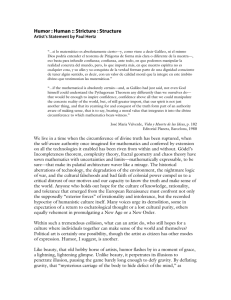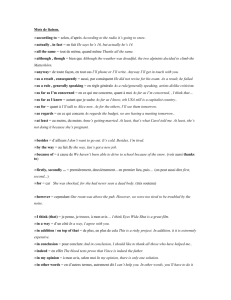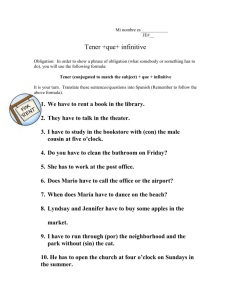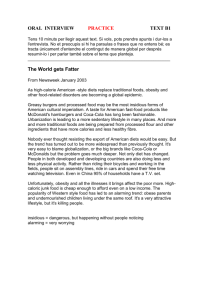Regimento proueytoso contra ha pestenença
advertisement
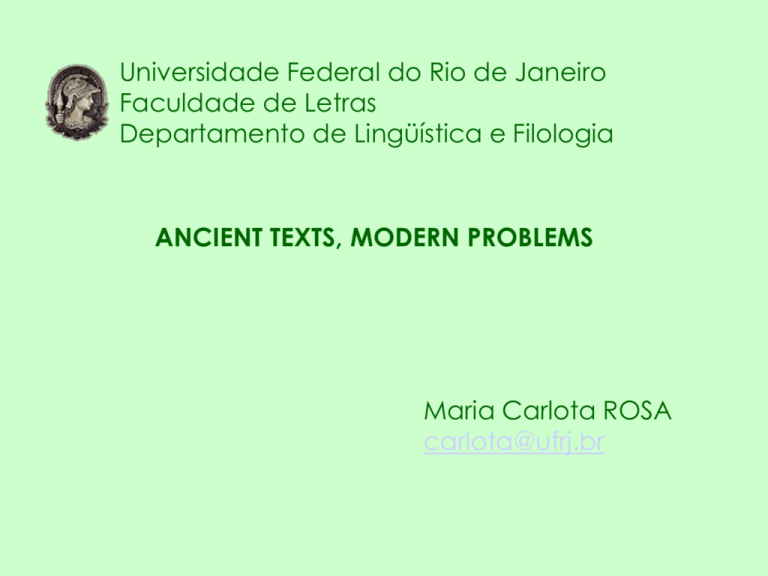
Universidade Federal do Rio de Janeiro Faculdade de Letras Departamento de Lingüística e Filologia ANCIENT TEXTS, MODERN PROBLEMS Maria Carlota ROSA carlota@ufrj.br INTRODUCTION In this paper I will focus on one of the first known medical works printed in Portuguese, the Regimento proueytoso contra ha pestenença (Lisbon: Valentim Fernandes, 1496?). Nowadays the Portuguese Regimento survives in two copies of the same edition, printed probably at the end of the 15th century by the German printer Valentim Fernandes, the most important printer in the period in Portugal, whose known activity in that country, in Lisbon, extended from 1495 to 1518 (Rosa, 1994). One of the copies stands in the Public Library at Évora, and the other, in the library of the ducal palace at Vila Viçosa, both in Portugal. According to Roque (1979: 287ss) the prime source for the Portuguese Regimento would be the medieval work De pestilentia. Its author was Johannes Jacobi, Latin name for Jean Jasme (or Jacme, Jacou, Jame, Jaume, old Portuguese Jemes, nowadays Jaime). He was a doctor who lived in Montpellier by the 14th century. If De pestilentia was written in Latin prose or verse it is still controversial, though the majority of the extant copies are written in prose (Roque, 1979: 288). The Portuguese edition and many others present the bishop of Arus, Raminto (or Ramitte, Canuto, Kanutus, Kamitus, Kamiutus, Kanunti) as the author. According to Roque (1979: 299), Raminto would have established a “syncretical text”, the Tractatus de regimine pestilentico, where he added some parts to Jacobi’s work, and omitted others. I will compare the Regimento to two other medical works. The first of them is A Moche profitable treatise against the Pestilence (London: T. Bertholeti, 1534), extant in the British Lybrary; the other is Recopilaçam das cousas que conuem guardar se no modo de preseruar à Cidade de Lixboa. E os sãos, & curar os que esteuerem enfermos de Peste (Lisbon: Marcos Borges, 1580), issue in the property of National Library in Rio de Janeiro. The first two treatises are unequivocally part of the same tradition. The third has some of the Regimento versions as one of its sources. The linguistic study of the innumerable medieval plague treatises may throw light on the continuities and on the disruptions of the so-called hippocratic-galenical medical tradition. This paper is divided into four parts. Part 1 outlines some characteristics of an ancient text. Part 2 concerns the Portuguese and the English issues of the treatise. Part 3 focus on the Recopilaçam. Part 4 presents some conclusions. 1.STUDYING AN ANCIENT TEXT When reading an ancient text the modern reader contacts a testimony of a different time, when neither copyright nor the concept of plagiarism were concerned. As noted by Febvre & Martin (1958:159), the profession of author would be born with the press. Before that, nobody had a monopoly on a text, which might be copied by whoever wanted to. More than that: Anyone might copy a text and change it, or add comments to it, or even suppress parts of it. So the fixity of the written text, a feature we are used to consider an inherent one, shared by all the issues of any text, took no part in that different cultural setting. In virtue of the differences the extant copies of ancient writings may present, part of the linguistic study of the known issues of a text tries to map its tradition, or the complex of reproductions of a text, no matter if extant or disappeared. Tradition is a concept closely related to the one of transmission, the process of successive reproductions of a text (Xavier & Mateus, 1990: I, 383). Jacobi or Jacobi-Ramintus’ work was an editorial success, since it had many editions in Latin, in French (Roque, 1979) and had also many English editions (Keiser, 2003). Roque (1979: 372-373) saw the suppressions and other kinds of variants as evidences of the poor quality of the Portuguese edition, when compared to French or Latin copies. This point raises an intriguing question, since many scholars, in the beginning of press, began to work to printers as proof correctors, whose work was concerned with both the supervision of the quality and correctness of the text and the decision to choose the best textual model to be the source for the new edition to come. According to the terms of some printing contracts the printer must provide a corrector (Atanásio Lopes, 1942; Pérez Pastor, 1895). Roque (1979: 273) tries to provide additional support to his argument by mentioning a comment Esteves Pereira had made on the Portuguese edition of Vespasian by the same Valentim Fernandes. In spite of his criticism on printings by Fernandes, Esteves Pereira’s edition of Vespasian has corrected Fernandes’ edition without criteria[1]. [1] Esteves Pereira’s edition substituted quasi-modern Portuguese forms for the old ones (as introducing deolho in place of archaic deilho) . He introduced sequences with no textual support, as e el rei where Fernandes’ edition had achey, an honorific title in the Far East. Pereira’s readings may be compared with the ones in the edition by Hook & Newman (1983). On the contrary Fernandes left many recordings of his attention to the textual models for his printings, as in his prologues to Auto dos Apostolos and to Marco Paulo. The way the transmission of ancient texts took place makes the modern reader deal with a broader concept of translation. Until the 16th century the Portuguese verb traduzir (‘to change from one language into another’) is not recorded. In its place was in use the verb traladar , but traladar (‘to copy, to transpose, to transfer’) comprised both activities the translation from one language into another and the rewriting of a text in the same language, introducing new words in place of the ones that had fallen into disuse, or introducing a different syntax, more suitable for the new readers. The Regimento proueytoso contra ha pestenença is a translation from Latin, and a translation for layman distant about a century from Jacobi. Friar Luiz de Rás ( 1521?), the translator, occupied the Chair of Natural Philosophy at the University of Lisbon, and was lecturer of Theology at the same University. It is difficult to imagine him as someone whose Latin knowledge was poor (see comments on Roque, 1979: 311-312). Two translations into Middle English and six printings antedated the English version by Thomas Paynell , who worked the English translation from a French issue (Keiser, 2003: 318). Paynell was a canon at Merton Abbey, and translated other medical writings (Keiser, 2003: 293). 2. THE PORTUGUESE AND THE ENGLISH VERSIONS OF THE PLAGUE TREATISE Both issues the Regimento proueytoso and A Moche Profitable Treatise appeal to ancient authoritative texts, a shelter for whoever wanted to write on any of all the important truths until the beginning of Modern Times (Grafton,1992: 1). The treatises mention Hippocrates’ Aphorisms (ca. 400 B.C.), Aristotle’s Meteorology (ca. 350 B.C), and Avicenna’s Canon of Medicine (ca. 1100 A.D.). Galen of Pergamum (ca. 2nd century A.D) was not mentioned, but both treatises have the same structure of another plague treatise, this one written in Spanish, the Tratado util & muy prouechosos contra toda pestilencia & ayre corrupto (Salamanca, 1507 - apud Freire da Silva, s.d.: 337), in which Galen is explicitly referred: [fol. 2v] Como scriue Galieno seys cosas sin las quales no podemos viuir & vsando dellas como conuiene son causa de fazer sanidad & guardar las enlos cuerpos vsando dellas en manera contraria que es no conueniente es causa fazedora de passion & destruydora dela sanidad las quales son estas. El ayre las viandas & lo que le sigue como el beuer & medicinas lo tercero henchimiento & su contrario velar & dormir exercicio o mouimiento & su contrario las cosas que al anima acaecen como son ira plazer pesares The Moche Profitable Treatise adds to the ancient authors the humanist scholar Ulrich von Hutten (1488-1523), who wrote a treatise on syphilis, De morbo gallico, in the 1520s. The Regimento has five chapters in the following order: the prognosis of pestilence, its causes, the remedies against it, the fortifiers (or confortations) of the heart and other organs, and the last chapter, on bloodletting. The Englisn edition has the five chapters present in the Portuguese edition. The fifth chapter is not numbered and precedes three other parts not numbered, To knowe urine (fo. [B2]-B3), A remedy for the frenche pockes (fo. B3-[B4]) and a codicil entitled To the reder (fo. [B4]). The Portuguese version has no section on urine, but it shows a comment on the misleading diagnosis the observation of urine may cause (fo. A3v), not present in the English version: mas ajnda tam sobejamente se agraua ha natureza que nom sinte sy ser ferida nem emferma. & jsto porque apareçem bõas ourinas & boõas augoas. & bõas digestiões. empero ho enfermo vay caminho da morte. E por tanto muytos medicos que em os enfermos soomente esguardam as ourinas superficialmente falam. & lygeyramente sam emganados. Ergo he neçessario que todo enfermo se proueja de boõ fisico & bem esperto. E estas cousas sam assy ditas das causas das pestilençia According to A Moche Profitable Treatise, the careful examination of the urine may lead the doctor to diagnose movement of air (“ventosities”) in the guts, phlegm humor, pain in the reins, in the knees, and also the virginity of a maiden and pregnancy. The section on the French pox is also absent from the Portuguese edition. As noted by Grafton (1992: 181), the writings on syphilis are part of the age of print. This is not surprising, since the disease came into attention and was named in Italy soon after 1494, when it was associated with the French troops (Grafton, 1992: 177), and the Regimento was probably printed in 1496 or even as early as 1491[1]. [1] Innocêncio Silva (1858-1958: V,319) dates Fernandes’ editon as prior to 1491: “O beneficiario José Caetano de Almeida, bibliothecario que foi d’el-rei D. João V [1708-1750 – mcr.] em um de seus apontamentos manuscriptos diz [....] que o livro de que se tracta fôra impresso em 1491, sem contudo indicar o modo como adquirira tal notícia”. For about 20 years syphilis would be described as a contagious and frequently fatal sickness, but that scenario would be changed by the middle of the 16th century (Grafton, 1992: 179). Near the end of the 16th century, for instance, William Clowes (1544-1604) attested to have treated more than one thousand patients with French pox during five years at St. Bartholomew’s Hospital in London (Grafton, 1992: 190), where he worked from 1576 to 1584. French pox was then widespread in Europe, but its victims were not segregated from other patients in the hospitals. The English translation by Paynell attributes the cause of syphilis to a conjunction of planets. Saturn, Mars and also Jupiter were higher rank planets, and their rare conjunctions were a warning of future radical changes (Carolino, 2002: 29). Paynell’s translation dates the French pox according to a conjunction of Saturn and Mars happened in January the 6th, 1496. The last part in the English version, To the reder (fo. [B4]), presents guaiacum (“ligno guaiaco” – fo. [B4]) as a remedy superior to any other (“I thynke it is nothing nowe comparable to that that Hutten wrytheth de ligno guaiaco”). The reference to the work by von Hutten is explicit. Paynell had also translated von Hutten’s De morbo gallico, printed a year earlier (Keiser, 2003: 321). As the doctor from Montpellier in the medieval work on plague, the German scholar attested his experience with the sickness and with the remedies against the French pox, and the benefits from guaiacum[1]. [1] Paracelsus (1493-1541) would maintain that the benefits guaiacum could bring were nothing but a commercial scam planned by the family Fugger, of Augsburg, who held the import monopoly on that wood from the New Word (Grafton, 1992: 193). Although very similar along the five chapters in common, the Portuguese and the English editions are different in other aspects. For instance where the Portuguese text presents the great doctor David, a representation of Christ (Di Berardino, 1983: 379-381) , the English version presents Jeremy: VIstas as causas da pestilencia. agora ajamos de veer per que modo & como se deue homem de guardar da pestilencia & preseruar se della. pollo qual deues de notar que segundo diz o grande medico .scilicet. dauid. que primeiro se deue o homem de afastar do mal & inclinar se ao bem.scilicet. que homem primeiramente ha de confessar seus pecados humildosamente. polla qual causa grande remedio he em tempo da pestilençia a sancta penitencia & a confissam as quaaes preçedem & sam muyto melhores que todas as mezinhas. (fo. A5) FOr almoche as we haue sene the causes of the pestilence, it is nowe conuenient to declare certayn remedies to withstande it. Wherfore ye shall note after the mynde of the supernatural phisition, spekyng by the mouth of Jheremie, that if a man will be surely cured, and haue a sure medecine, he must leaue his synnes, and confesse hym self with humilitie and great repentaunce. For in tyme of sykenes confession and penaunce shulde be preferred aboue al other medecines. (fo. A 5) Rás and Paynell translated the same work, but had different sources, and had different audiences in mind. Jacobi-Raminto’s work was still profitable in the 1530s, since epidemics of plague were still recurrent[1], but from the first half of the 1500s on the crises were violent but more and more spaced out. At the end of 16th century plague was no more the main cause of mortality in Europe (Rodrigues, 1990: 22). In place of plague the beginning of the 16th century would have other diseases, and among them a new type of pestilence, so widespread and fatal that deserved attention too. [1] There are records for epidemics of plague in Portugal for the years 1190-1191, 1202, 1223, 1333, 1356, 1384, 1423, 1433, 1435, 1437-1438, 1448, 1458, 1464, 1477, 1480-1497 (Marques, 1964: 93). 3. Recopilaçam das cousas que conuem guardar se no modo de preseruar à Cidade de Lixboa. E os sãos, & curar os que esteuerem enfermos de Peste The doctors Tomás ÁLVARES (fl. 15--) and Garcia SALCEDO Y CORONEL (? – 1651) were called from Seville to Lisbon by King Sebastian(1556-1578) in 1569, during one of the epidemics of plague in Portugal during the 16th century. Their work would be reprinted in 1598 and in 1580, during epidemics of plague. Y como el principal fin para que [V.A.] nos mãdo por sus Reales cartas venir fue, para que [a los?] medicos desta Ciudad communicassemos los remedios que este mal podria tener (fo. 1v) Their knowledge must present answers to the questions they had heard from different doctors: y en su presencia se moueron [y] determinaron las dudas que cada vno quiso mouer [ ] por auerse nos mandado diessemos por escripto lo que fuesse conueniente pera remediar tanto daño, nos parecio hazer una breue recopilacion (fo. 2) Both professionals compiled everything they could: emos procurado de no dexar cosa de lo que bien escriuieron los que dello tractaron, antes añadiendo algunas particularidades muy necessarias para la cura fundada en razon y larga experiencia (como en ellas se podra ver) en lo qual no poco trabajo hemos tenido por la breuedad del tiempo, y peligro de la tardança [....](fo.2r). When reading this compilation, it is possible to recognize parts that are similar to the Regimento. However the Recopilaçam seems nearer to the modern reader than the Regimento. Punctuation had new principles, and new signs were introduced; acute and grave accents on the vowels were introduced to show stress or vowel quality and crasis; the tilde is basically the only abbreviation; the font was no more the gothic. The language in which it was written is also different, although some ancient forms are still present[1]. [1] The old termination in --am in place of modern -ão is present in some words, as nam ‘não’, sam ‘são’, but many others have the modern orthography, as opilação, inflamação. It is possible that the readers living about seventy years after the edition by Fernandes of Jacobi-Raminto’s work could no more understood it. In this sense a comment by Friar Manuel do Sepulcro on linguistic changes in Portuguese from 1495 to 1515 may support that hypothesis: 4. E naõ ha duvida que mayor mudança fez a lingua Portugueza nos primeiros vinte annos do reynado de D. Manoel, que em cento e sincoenta annos dahi para cà como o vemos pelos escritos, em verso, e prosa, de huns, e outros tempos The modernization made by the Spanish doctors affected the contents too. The arabic influence of a kind of work known as lapidarius is present, and many recipes in the book had gems as ingredients (“O trazer pedras preciosas principalmente Esmeraldas & Iacinthos, & trazendo se que toquem aa carne sam melhores” – fo. 107). The triaca receives adjectivation now: triaga magna, triaga de esmeraldas. The bolo armênico is also prescribed. 4. CONCLUSION While those writings are related, they are part in different cultural settings, and must not be read as poor versions of an ancient original. The translations by Luiz de Rás and by Thomas Paynell may sound awkward to a modern reader, but a modern reader was not part in the intended audience those scholars had in mind. Missing excerpts are not necessarily a product of a forgetful printer or translator. In the case of medical writings, they may evidence different ways of carrying out medical treatments. References [Jacobi, Johannes ?] s.d. [1496?] Regimento proueytoso contra ha pestenença . Transl. by Fr. Luís de Raz .- Lisboa: Valentino de Morávia. BP.Évora, Inc. 210 [JacobiI, Johannes ?] 1534. A moche profitable Treatise against the Pestilence, translated into Ẽglyshe by T. Paynel Chanon of Martin Abbey. Transl. by Thomas Paynell. T. Bertholeti: London, 1534. British Library 1167.d.7. Álvares, Tomás & Salcedo y Colonel, Garcia. 1580. Recopilaçam das cousas que conuem guardar se no modo de preseruar à cidade de Lixboa, e os sãos &. curar os que esteuerem enfermos de peste / feita pellos Doctores Thomas Aluares & Garcia Salzedo, vezinhos de Seuilla & medicos do serenissimo Rei de Portugal, Dom Sebastiam Primeiro, nosso Senhor... . - Em Lixbo [sic] : por Marcos Borges, 1580. BNacional,Rio de Janeiro, W3, 5,3,n.5. Anônimo. 1496. Estoria do muy nobre Vespesiano emperador de Roma. Lisboa: Valentino de Morávia, 20/04/1496. Fac-símile: Biblioteca Nacional de Lisboa. 1981. História do mui nobre Vespasiano imperador de Roma. Nota prévia de A. Anselmo. Lisboa: Biblioteca Nacional. Edições: Hook, D. & Newman, P. 1983. Estoria do muy nobre Vespesiano emperador de Roma (Lisbon, 1496). Exeter: The University Press. Pereira, Joaquim Maria Esteves. 1905. Historia de Vespasiano imperador de Roma conforme a edição de 1496. Lisboa: Typ. Ferin. Atanásio Lopez, P. 1942. la imprenta en Galicia. Siglos XV-XVIII. Madrid: Patronato de la Biblioteca Nacional., 1953. Carolino, Luís Miguel. 2002. A escrita celeste: Almanaques astrológicos em Portugal nos séculos XVII e XVIII. Rio de Janeiro, Access. Di Berardino, Angelo, org. 1983. Dicionário patrístico e de antigüidades cristãs. Transl. by Cristina Andrade. Petrópolis: Vozes, 2002. Febvre, Lucien & Martin, Henri-Jean. 1958. The coming of the book. London: Verso, 1997. Freire da Silva, Marinalva. [s.d.] Edicion critica del Regimento proueytoso contra ha pestenença (¿1496-1500?). Madrid: Universidad Complutense. Tesis Doctoral. mimeo. Grafton, Anthony. 1992. New worlds, ancient texts: The power of tradition and the shock of discovery. Cambridge, Mass.: The Belknap Press of Harvard University Press, 1995. Keiser, George R. 2003. Two medieval plague treatises and their afterlife in early modern England. Journal of the History of Medicine and Allied Sciences. 58 (3):292-324. July 2003. Manuel do Sepulcro. 1699. Refeição espiritual para a meza dos religiosos e de toda a devota familia [....] 1. Parte hyemal. Lisboa: Miguel Menescal da Costa, 1742. Marques, A. H. de Oliveira. 1964. A sociedade medieval portuguesa: aspectos da vida cotidiana. 5ª ed. Lisboa: Sá da Costa, 1987. Pereira, Joaquim Maria Esteves. 1922. O livro de Marco Paulo. O livro de Nicolau Veneto. Carta de Jeronimo de Santo Estevam conforme a impressam de Valentim Fernandes feita em Lisboa em 1502. Lisboa: Biblioteca Nacional. Perez Pastor, C. 1895. La imprenta en Medina del Campo. Madrid: Sucessores de Rivadeneyra. Rodrigues, Teresa. 1990. Crises de mortalidade em Lisboa. Séculos XVI e XVII. Lisboa: Livros Horizonte. Roque, Mário da Costa. 1979. As pestes medievais europeias e o “Regimento proueytoso contra ha pestenença”, Lisboa, Valentim Fernandes (1495- 1496): tentativa de interpretação à luz dos conhecimentos pestológicos actuais.Paris: Fundação Calouste Gulbenkian/ Centro Cultural Português. Rosa, Maria Carlota Amaral Paixão. 1994. Pontuação e sintaxe em impressos portugueses renascentistas. Rio de Janeiro: Universidade Federal do Rio de Janeiro, mimeo. 2 vol. Silva, Innocencio F. da. 1858-1958. Diccionario bibliographico portuguez Lisboa: Imprensa Nacional. 22vol. Xavier, M. F. & Mateus, Maria Helena. [1990]. Dicionário de termos linguísticos, Lisboa: Cosmos. vol. 1.

